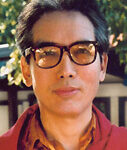| The following article is from the Winter, 2003 issue of the Snow Lion Newsletter and is for historical reference only. You can see this in context of the original newsletter here. |


While many people want to learn Buddhist meditation, they are often very sceptical and uneasy about the philosophies and religious elements that go with it. Many think that Buddhist practices and meditative experiences can be easily separated from belief systems within which they are embedded. Many have the idea that belief systems, especially religious belief systems, are dangerous and regard anyone who is a "believer" as a dogmatic person. They think that those who subscribe to a religious belief system have completely shut their minds off from new ideas and remain mere prisoners of tradition. For this reason they are afraid of being "converted" when they are introduced to Buddhism, automatically regarding that possibility as a terrible outcome. However, that notion is highly questionable, as we have to make use of certain Buddhist concepts in order to make sense of meditation practice. For example, to do meditation we have to believe that there is such a thing as spiritual liberation and that ignorance and the defilements of the mind inhibit us from realizing that goal.
There is some truth to the perception that people can be very opinionated and fundamentalist in the way that they cherish their beliefs. However, that does not mean that we can embark on a spiritual path without believing in certain fundamental elements of spirituality. Although it has been said that we should learn to dispense with our beliefs, if we have no philosophical orientation we will have no idea what we are trying to achieve, where we are trying to go, or what sort of personal predicaments or psychological and spiritual conflicts we are trying to understand.
When we discuss Buddhist meditation practices and experiences, we always discuss them from a particular perspective. It is not a matter of thinking that the Buddhist way is the only way or that it is superior to all other religious or spiritual traditions. It is simply that the Buddhist approach to realizing the ultimate truth and discovering the sacredness of spiritual reality can only be attained through adopting a particular viewpoint. This is why Buddhists talk about developing the correct view.
The correct view is called the "noble view" and the incorrect view the "ignoble view." The things that we believe in must come from having adopted the noble view (samma ditthi in Pali, samyha drsti in Sanskrit, yang dag pa,i lta ba in Tibetan). Instead of thinking that we should not believe in anything at all, we need to learn the appropriate things to discard from our belief systems, even in relation to spirituality. Through the process of refining our views, we learn how to re-orient ourselves on the spiritual path, realizing that liberation and our belief systems are intimately related.
Correct views have the ability to lead us to liberation, while incorrect views can distort our spiritual goals, increase the delusions of our minds by encouraging our delusory mental states, fan our anger, and increase our sense of superiority and pride. That is why we need to have a proper orientation the "correct view" when we embark on the path. The correct view is the transport that we need to journey from the bondage of samsara to the liberation of nirvana. There is no separation between the vehicle that transports us to our spiritual destination and the views that we hold in our minds.
We should not think that meditation is all about discarding views or that all views will restrict us from attaining our spiritual goal. For example, even if we have no intention of becoming a Buddhist but want to practice meditation, this indicates that we already think that our lives are incomplete and that the only way to find any kind of ultimate fulfilment is through something spiritual. This kind of thinking requires a lot of conceptual categories, schemas and various pre-existing beliefs. In other words, we do not have to transcend all viewpoints to have meditative experiences. What we experience in meditation may be independent from the particular viewpoints that we hold, but those viewpoints can help to steer us toward the appropriate meditative experiences. What we are experiencing in and through meditation has to be made sense of. In order to acquire this understanding, we need to interpret the given experience and this interpretative act requires the appropriate use of conceptual categories, i.e., is it veridical or non-veridical, etc.
It is very important to try to understand meditative experiences by consulting the voluminous historical literature that describes them. We are often told that meditation is about emptying the mind, that it is our discursive thoughts that agitate our minds ensuring that we remain trapped in the world of appearances. However, without making use of any kind of conceptual formulations, we cannot really attempt to have any meditative experiences. We would be unable to discern what sorts of mind-states were conducive or detrimental to meditative experiences.
Some meditative experiences may have the appearance of being genuine but in reality they are false or misleading experiences. These non- genuine experiences can be deceptive, giving us the false conviction of having attained a particular meditative state, when in reality we have simply gone astray or fallen victim to fanciful thinking. To separate the wheat from the chaff, so to speak, and endeavor to find out whether anything genuine has occurred or not, we have to make use of conceptual tools that can steer us in the right direction.
Correct views are also connected to liberation, because they lead to proper understanding. Proper understanding leads to insight or transcendental knowledge (prajna), which in turn gives rise to gnosis (jnana). In traditional Buddhist teachings, first we speak about prajna and jnana. We also speak about view, meditation and action. In order to cultivate transcendental knowledge or prajna we need to hear, study, and contemplate the teachings and then meditate on their meaning. In Mahayana Buddhist literature, conceptual understanding is always a precondition for the dawning of gnosis or jnana. Therefore, unless we have a correct view, we will never have a proper understanding of spiritual matters. For example, we should have a correct conceptual understanding of emptiness. We cannot simply do meditation and hope for the best. We have to have a conceptual framework to work with and that conceptual framework has to be dependent upon a correct view.
The correct understanding comes from becoming familiar with the teachings. The Buddhist teachings are supposed to have four characteristics, according to Mahayanauttaratantra: (1) the quality of leading sentient beings to enlightenment; (2) the words that express the meaning are devoid of any linguistic imperfections; (3) the function to eliminate mental afflictions; and (4) the purpose of pacifying suffering of sentient beings. Any teachings that fail to meet these requirements would then be the cause of engendering wrong views.
Through familiarizing ourselves with teachings that have these four characteristics we develop a proper understanding that does not simply remain on an abstract level. By studying and becoming familiar with the teachings, we appropriate their content into the continuum of our own experience. In that way, the teachings and our own inner experiences become inseparable. This is why it is sometimes said that there are the outer expressions of the teachings and the inner expressions of the teachings—the outer expressions being teachings in written or spoken form and the inner expressions being one's own experiences. This is called lung dang tog pa in Tibetan. The teachings of the lung, which means "the written and oral traditions," are contained in the Buddhist canon in the form of the Kangyur and Tengyur. The Buddha's own direct discourses are known as Ka, while the commentarial material on these discourses are known as Tenchoe (the Tengyur contains the general commentarial texts, while the Tenchoe contains commentaries strictly related to Ka). Tog pa means "the inner understanding that develops from having appropriated their content into our own continuum of experience."

We cannot do without the viewpoints related to our belief systems, because it is only through them that we can make any sense of what we are experiencing.
In Buddhism, therefore, we have to practice meditation through understanding the teachings and placing our own experiences in the context of those teachings. We have to appreciate the fact that they cannot be separated. The understanding that one develops through appropriating the teachings into one,s being is liberating in itself. It is not the case that we first have to understand the teachings, then do certain practices and then find liberation.
The teachings are important to us, not because they were given by Sakyamuni Buddha, but because the Buddha realized the content and the significance of the teachings in himself and then passed that down to us. The Buddha was not in a privileged position to access the content and the significance of the teachings, nor are we at a disadvantage. We cannot say that the Buddha achieved a total assimilation of the teachings so that there is a completely direct connection of the truth to him. We are distant from the Buddha in every way in terms of time and in terms of our existential condition but by developing the correct view and practicing meditation, we can learn to assimilate the content and significance of the teachings. As a consequence, we can also become liberated.
It is also important to have a comprehensive world-view, because we cannot treat meditation as a way of dealing with one aspect of our lives. If we are going to practice Buddhist meditation, we have to have a comprehensive view of our human nature, our place in the scheme of things, and our relationship to the world in which we live. All of these things have to be taken into account when we do meditation. Otherwise, our world-view will not be comprehensive, but fragmentary and as a result we will become confused about life.
As stated above, while we should not regard Buddhism as the religion that has the truth, while other religions and spiritual traditions are wrong, we have to realize that each religion is a competing world view and therefore unique unto itself. However, we have to embrace a particular world view in order to function properly in this world. This does not mean that we have to regard one world view as true and all the others as false, but we have to approach our meditation practice from a Buddhist point of view. We cannot say, "I'm doing meditation in a way that world views do not matter."
Buddhism has many stories about the utilitarian nature of the teachings. The Buddha said that the teachings are like a raft for crossing a river. Once you have reached the other shore, you do not need to carry the raft anymore. There is also the Zen story that suggests the teachings are like a finger pointing to the moon, where once you see the moon, you no longer need to rely on the finger any more. However, people misunderstand these metaphors when they perceive them to mean that people should reject all belief systems. The point of both these stories is that the boat and the finger are initially a spiritual necessity.
It is only after the content and the significance of the teachings have been assimilated into one,s mind- stream, so that there is no separation between the teachings and oneself, that one no longer has a need for conceptual tools. Up to that point, conceptual tools are completely necessary, just as it is necessary to have a boat in order to cross a river. The important point here is that these conceptual tools the world views and belief systems are our means of transport. Like with any kind of transport, one has already embarked on a journey as soon as one has entered that vehicle. Similarly, as soon as one has assimilated a certain kind of spiritual world view, the effect has already taken place. One has already been liberated. The understanding that one develops, through appropriating the teachings into one,s being, is liberating in itself. It is not the case'that we first have the understand the teachings, then do certain practices and then find liberation. The assimilation of the teachings is the same as liberation—that is enlightenment, that is the goal.

